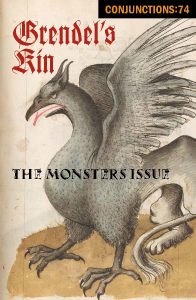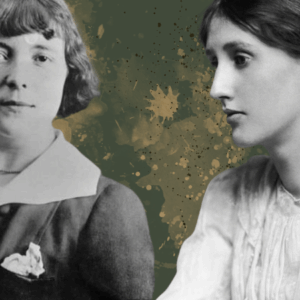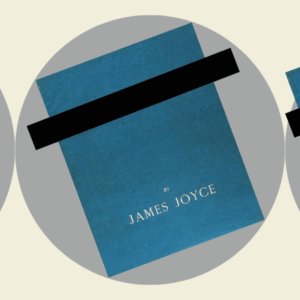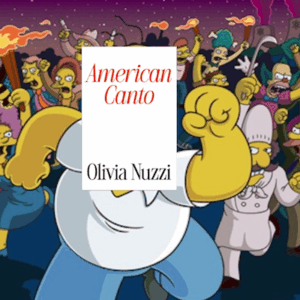
There Be Dragons. In This Essay.
Arra Lynn Ross on Old Norse Translations and Decoding Myths
It is early April. Night’s small snow lines the deck, the lips of open narcissi, the new roof. Over the high, thick buds of maple, mad in wind, darker thicknesses of cloud move fast. From the kitchen, my husband on his banjo, working a song he’s worked for years. Then, quiet. From the library, cat teeth on hard kibble. On the blue-and-white rug, the dogs, at my feet, gather, while in the far field, snow on feathered wings, comes, farther down, the dragon.
I drag, from the back porch, the cold five-gallon plastic bucket, bent awkwardly, shuffling, with the handle between my spread legs. The water sloshes, wets my jeans at the knee. Silver and green, a slick fin quivers, folds close to the wide, black-spotted back, and the gold around a black pupil flashes.
*
I first translate the Old Norse’s cosmogenic/apocalyptic poem, Völuspá’s last stanza like this:
In that place, comes, inside the dimming,
dragon, flying-breath,
snake-bright, flashing bright, shimmer-shiver from below
from the dark-moon, from the mountains;
Naked, bare, she carries on in motion towards, with
feathers
—over the field—
higher down.
Now remember, she comes down.
*
That is where the whole poem ends.
*
I want to point out something of interest, using two words from the original text.
“Dreki fljúgandi” could be simply translated as dragon flying, or dragon-ship flying. However, here, I’m interested in the second word, in which “-andi” is added to “fljúga” (to fly), orfljúg (flight), to make it a present participle, thus, “flying.” Andi, though, in and of itself means, I read, spirit, or breath. Thus, in the Old Norse language, adding spirit or breath makes something move continuously in the continuous present moment.
The other word I’d like to point out is in the third line, “naðr,” which translates as snake or serpent, and is used to describe the “dreki.” However, when added as a suffix at the end of a word, –naðr acts to change a verb, or even an adjective, into a noun.
Thus, the serpent gives body and form to a movement or quality, this language implies.
For example, to dance + serpent = the dance.
Or, of the earlier one: to dance + breath = dancing.
*
H. J. Rob Lenders and Ingo A. W. Jannsen point out that the grass snake, which lived symbiotically, physically, and symbolically, with humans for millennia, suffered after the advent of Christianity. They write that “probably the single most important symbol of pre-Christian chthonic fertility gods, the grass snake, was turned into the number one enemy of the one and only heavenly God.”
In Scandinavia, in 1555 AD, the Swedish Archbishop Olaus Magnus, in his copious Historia de Gentibus Septentrionalibus, wrote, in Volume II, Book 21, Chapter 48, of these “pet serpents, which in the farthest tracts of the North have the reputation of protective deities. They are reared on cows’ or sheep’s milk, play with the children indoors, and regularly are seen sleeping in their cradles like faithful guardians. To harm these creatures is regarded as sacrilege.
“However, such practices are survivals from ancient superstition, and since the adoption of the Catholic faith are completely forbidden.”
*
The grass snake is also known as a water snake (Natrix means “of water”). It likes to eat fish, and can raise its head far above the water while swimming. Dark bodied, but with a gold ring around its neck.
The paint has worn from the face, from the brow, from the open almond eyes. The subtle bridge of a long face, like a deer’s, sheared off, broken, at mouth and nose.
It lived with humans for so long because heat hatches its eggs. Best are places that give heat as they decay: cattle dung, compost piles, barns with manure piles. Or else, near ovens.
*
My mother calls to tell me this dream:
She was tall, very tall, like seven feet tall, wearing an obsidian wet suit with gold at the top. She looked like the mosaic in the Swedish capital city hall. In my dream it was night. I was standing in the driveway wearing my black insulated gloves and a coat. I was on the right side of the driveway. To my left, standing on the snow, the figure asked me if I knew who she was. She said, “Do you know who I am?” I replied, “The lady of the lake,” with assurance.
She said, “I have seen you with the ice in your fists. What do you intend to do when you make a fist and ice appears in your fist?” “Let go,” I replied. I let go in my dream and a fish fell onto the snow. It was a cod (you know this is the fish of the Norse mythology). I made a lot of fish (you know, they’re all lying on the snowbank). She said, “Yes, what you do with your hands, you can bring to market.”
*
I pull my enormous unabridged 1960s Webster’s New International Dictionary down on my lap, intending to open it randomly to find any old verb to use as another example, as dance did in a few paragraphs above. However, it opens to page twenty-nine, and my eyes, of their own accord, fall upon the word adder, which it says derived from Anglo-Saxon naedre, snake, “akin to” Old Norse naðr, and Latin natrix, water snake. Apparently, the loss of the “n” was a mistake.
*
The next day, the rain comes down hard and the power goes. I rip three small flowering twigs from the ends of my quince and put them in a tiny pale-blue bottle, a cube, with bubbles trapped in the glass. The pale five-petaled flowers are infused with an almost imperceptible pink just where the petal widens, then curls either inward, or out.
Paler, but not much, than the blush where bone joint meets breast, the inward curve against tendon, against rose-shivered skin, where the smallest feathers, delicate, round as petals, and, like petals, or leaves, traversed with increasingly fine and many-branching rivers. Calamus, I read, is the word for the hollow shaft from which these filaments spring. Here, in the down (dünn, in Old Norse), the calami bend inward, their pearl-fingernail-horn translucence cupping the feather petals toward skin.
The field is wet. The hollow shafts of bluestem and their empty awns, soaked dark gold. I have yet to cut them so their spring shoots can grow. By the time I get to the far field, my jeans squeak, cling hard, cold wetness burning my thighs.
*
Dansarens häll, the Dancer Stone, Cambrian sandstone bedrock carved on thousands of years ago, at Järrestad, in Sweden, has at least five serpents, along with ships with upraised serpent-like heads. One naðr has a deeply spiraled tail, and another, the most intriguing, has two parallel lines forming the snake’s thick body, two deep meanders, the tail a quick spiral, its head resting against a shoe.
*
Should I talk about the pink ball of the child’s foot? Less pink, the thick paint, there, than on the dragon/dreki’s shoulder, though about the same shade where the long face tucks to the curled neck.
This is from the church sculpture of the Madonna from Edshult’s Church/Kyrka in Småland, Sweden, carved between 1325 and 1350 AD.
The figure, under her feet, is pink as the child’s upturned sole, as the top layer of cracked paint that remains on her bared breast, where the child’s hand rests.
The tail, curled in one loop, touches her right shoe, disappears beneath the robe’s once blue folds. The body thickens, Mary’s left foot on its shoulder, above a small arm tucked beneath the head, much like a cat. The ears, laid back against its curved neck, long as a rabbit’s, ripple, thin to a fleshy point.
The paint has worn from the face, from the brow, from the open almond eyes. The subtle bridge of a long face, like a deer’s, sheared off, broken, at mouth and nose.
*
Action: I’m trying to tell you there is a dragon in my field.
Action: I’m trying to tell you, far, with pasqueflowers.
Action: I’m trying to tell you “naked, bare, unsheathed.”
*
Is it useful to add that Tacitus, in his 98 AD Germania, comments that “the Germans do not think it in keeping with the divine majesty to confine gods within walls or to portray them in the likeness of any human countenance”?
*
Níð höggr, nái is the line I struggle with most, in the last stanza of the poem. Nái. Corpse. Most translators agree, and yet . . . What if we considered other instances of nái, as a preposition, of ná, thus meaning near, close, nigh.
In the Old Icelandic dictionary, I read that nái is a plural of nár, as an accusative (i.e., object of a verb), thus, carries the dead. But, as a verb, it means “to get hold of, to reach, overtake, to obtain.” Or, as a version of nári, feeder, nourisher.
There does seem to be held, in the word, simultaneously, a sense of life, death, and something passing between, from one to the other.
*
Outside, another butterfly, small, moves on strange wings, over the greening grass. The tulips, warm and red, open.
I appreciate Ursula Dronke’s note: “This is a very rare image. The late Otto Pächt assured me that he knew of no representation of a dragon bearing bodies in its wings.”
*
Perhaps we should talk about those wings.
Berr sér í fjöðrum. Let’s take it word by word, and see what unfolds:
Berr: bare, naked (in the open air); open, clear, manifest.
In the Old Norse poem Vafthrudnismál, stanza 47, second line, “berr” is translated as “to birth” when the old sun gives birth to her daughter, the new sun who “will ride / as the gods are dying / the old paths of her mother.”
sér: a reflective pronoun meaning (1) for oneself, separately, singly, (2) in a distributive sense, each by himself, each separately, sometimes each of them singly.
í: (1) in, within; in a certain spot; in, among; during, in; denoting action, state, condition; in respect of, in regard to; denoting form or content; by means of, through; (2) with: in, into; of time: in, during; denoting entrance into a state, condition; denoting change (into); denoting the purpose.
fjöðrum: from, I think fjöðr (gen. fjaðrar, pl. fjaðrar), a feminine noun meaning (1) feather, quill; (2) fin or tail of a fish ; (3) blade of a spear.
*
Bare naked, gives birth, oneself changing into feathers—or, into a fish, or, into a spear—
*
There are no dreki/dragons with wings in the old stories. Only big serpents. Wings and feathers belong solely to prey ravens and swans/egrets, never even to Valkyries, who fly upon (unwinged) horses. Wings belong to the swan-maiden tales, and to Freyja in her fiaðrhamr, or “feather body garment,” as Dronke translates it.
I find, in that Old Icelandic dictionary (so similar to Old Norse) that hamr means (1) skin, slough; as in “hleypa hömum,” to cast the slough (of snakes); and (2) shape, form. Further, ham-ramr means to be able to change one’s shape, and ham-remi, a feminine word, means “the state of being hamramr,” whilehams, itself, means simply “snake’s slough.”
Here, then, we have a mixed thing: the feather garment and the snake skin are one.
Shape-changers—
*
I go back to the oldest source. One can find the last stanzas of the Völuspá, within the Poetic Edda, Codex Regius, a picture of the gray-brown vellum calfskin, online.
The stanzas are not broken up. Instead, the stanza shift is indicated by a capital letter only there. One period, and no other capital letters are found within the work.
It reads something like this:
Par kõe in dimi dreki naðra nap [j?]a [z?] n? ne[j?] [smudged here, too much, to read] m / nipa mollõ. ber [or is it bek?] ser imoprõ [or ö] plygr vaill yr niphagr [this is a bit blurred]/ nai nu m h s Seyagz [blurred].
The translations we have of the Völuspá are a compilation of blurred letters and words drawn from two different manuscripts—the Eddic and the Hauksbók.
*
Here is the most honest translation I can make, for what has previously been accepted, and translated as a corpse-bearing monster from the underworld:
There at that place cows in dimness dragon snake floating [ ] / dark-moon dust. To bear, to carry, [or, to adorn the bench] each ember flies [the field] yew tree dark-down-giving-wise-counsel-to-put-right / near, and nearer now [ ]
The “dragon” carving is rough, a gashed cross on the flat below an eye, a deeper gash where bent head meets arched neck. Still, the wood shines, worn soft by much touch.
The almond-shaped eyes are carved like the eyes of mother and child, but without delineated upper lids. Still, the long, curved brow and turn to the bridge of nose are very similar, just softer, wider, in the dragon.
At Järrestad, not far from the serpents, a rich splattering, deeply ground, some a little bigger, some smaller, rise up the Cambrian slope.
Open, the bare eyes, though the gesture of cheek upon small toes placed side by side, under, is quiet, is careful.
*
Some paint remains in the inner elbow and triangle of tucked-up paw, where the head rests. The undercoat is silvery pink marred with small cracks, as in old plaster. On top of the pale pink, a wash of wide, darker pink stripes on which, in warm red, someone has painted the pattern of scales, or maybe feathers, or petals, like a child would draw, each made with a long U, inside of which three or four lines, evenly spaced, brush down from the open end to the curve. The scales do not touch, and between the rows of scales, on the pale pink, is a row of evenly spaced red dots.
*
For the Japanese artist Yayoi Kusama, the dot “is a vortex into another universe.” It is “a way into infinity.” It “has the form of the sun, which is a symbol of the energy of the whole world and our living life, and also the form of the moon, which is calm.”
“Round, soft, colorful, senseless, and unknowing,” said Kusama.
The dots on Scandinavian Bronze Age rock carvings, some argue, are also for the sun. They call them “cup marks.” Such marks are found in rock carvings all over the world.
At Järrestad, not far from the serpents, a rich splattering, deeply ground, some a little bigger, some smaller, rise up the Cambrian slope. It feels good to run a thumb down them. They seem more or less evenly spaced. At the top of the long, thick column of dots, two feet, heels together, point down, each toe also a deeply ground, very circular, dot.
*
At other carvings, a dot between the legs marks, some think, woman.
*
My mother, a girl, pulls her knees up and over onto the hayloft of the barn. Bits of broken straw bite the fat of her thumb, the cap of her knee. Once free of the ladder hole, she scoots a little farther, then pulls her feet beneath her. She hears the bodies of cows, from below, moving against each other, a snort, a single low.
It is not dark up here, as she had feared. Shafts of moon fall from chinks in the vaulted ceiling onto piles of loose hay. She scoots to a close, narrow shaft; inside, she arches her fingers back and palms up till the lines etched in skin disappear.
A fleck of chaff dust floats down, sparks—a stirred ember. In the half-second flare, she sees, in minute detail, her own face wear away to become, first, fire of sun’s innermost parts simmering over a hundred millennia to surface, then flying, light, swift minutes to touch moon’s black basalts and crushed breccia facets, to cross, reflected, the bare second to the ceiling’s open crack, and trace, now, the girl’s near palm: rose-shivered flesh where even the smallest filaments—feathers, hairs, dragon scales—traversed with fine and many-branching rivers—are hallowed.
__________________________________

From Conjunctions: 74 (The Monsters Issue). Reproduced by permission Copyright © 2020 by Arra Lynn Ross.
Arra Lynn Ross
Arra Lynn Ross is a poet, essayist, and puppet worker. Her book Seedlip and Sweet Apple, published by Milkweed Editions, takes on the voice of Mother Ann Lee of the Shakers. Her second book, The Day of the Child, will be published by Milkweed in 2021.












